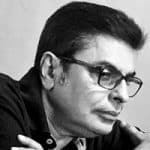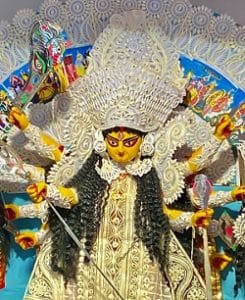
Baidyabati, a portmanteau word, derives its name from Baidya (doctor) and Bati (home). Loosely translated, it means the home of doctors. The origin of Baidyabati dates back to the late twelfth, or early thirteenth century. During that period, the local Sena dynasty, which had been ruling Bengal for two centuries was on the decline. Seizing the opportunity, Bakhtiar Khilji a Turko-Afghan marauder, invaded Bengal, capturing key territories including Gauda, the capital, leading thereafter to the establishment of Islamic rule in Bengal.
Fearing extermination, a group of resident physicians (Baidyas), fled to the banks of river Hugli, carrying their manuscripts, and expertise with them. Travelling down south to set up their homes, (Bati), they soon formed a large settlement, turning the place into a populous hub. Most of the Baidya families carried the surname Gupta. Among the cultural traditions which the Baidyas brought along with them was Devi puja or the worship of the female goddess, which continued over centuries. Though the modern version of Durga puja was believed to have been introduced in the 18th century6 it seems that an earlier version existed well before this time. Historians may find this interesting.
The Medicine Man and his cultural roots
While the antecedents of most of the Durga pujas in Baidyabati remain hazy, we do have a clearer picture regarding the Bakshi-barir pujo, from the nineteenth century on wards. This is largely due to the information on Madhusudhan Gupta, a scion of the Gupta family. Madhusudan’s stellar contribution to Indian medicine is recorded in several books and journals. Details about his personal life, including the Bakshi-barir pujo, get occasional mention in these writings
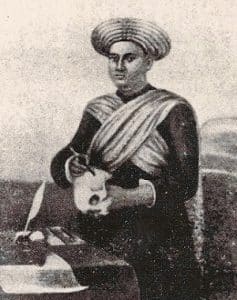
Born in 1806, to a Gupta family at Baidyapara, Madhusudhan, who ironically, had scant interest in education during his boyhood, grew up to become an exceptional physician. Following family tradition, he initially learned Ayurveda medicine at the Sanskrit College in Calcutta, where his brilliance became evident within a short period of time. Along with Ayurveda, Madhusudhan learned Sanskrit, Logic and Linguistics, which gave him a more expansive world-view. During his visits to different locations to treat patients, Madhusudhan became increasingly interested in the discipline involving the study of human anatomy. To gain further insight, he learnt English, in order to read up Hooper’s Anatomy vade-mecum. Madhusudan’s Bengali translation of Hooper’s book earned him 1000 rupees, a fortune in those times.
In 1835, with the establishment of Medical College in Calcutta, Madhusudhan took up the job of a Demonstrator and Assistant Professor. It was here, in 1836, that he created history through an act which gave Indian medicine as well as society a new direction. On the 10th of January 1836, he went ahead and executed a flawless dissection on a cadaver, becoming the first ever Indian to perform this procedure.
As is well-known, a large section of the nineteenth century Bengali society was steeped in caste and class prejudices, and physical examination of a human body was a strict taboo. Despite being a devout Hindu, Madhusudhan did not allow religious obscurantism to cloud his scientific pursuit. Risking ostracization, he went ahead with his decision, which provided valuable insights for the medical discipline in Bengal. This historic event is mentioned in the writings of John Drinkwater Bethune, a pioneer of nineteenth century women’s education and the founder of Bethune School (which subsequently became a College) the first of its kind in Calcutta in 1849. Bethune describes Madhusudan’s feat as “memorable in the annals of Bengal” in which “Madhusudhan Gupta … flung open the gates of medical science to his countrymen.” Madhusadhan’s seminal act has more than historical significance. It underscores the catholicity of an individual whose scientific spirit coexisted with his deep spiritual and religious beliefs. While continually championing the advance of medical research, Madhusudhan remained rooted to his culture, as is evidenced by his participation in his ancestral home-the Bakshi-barir pujo. The puja tradition continues to this day, with the current members of the Gupta family congregating every year to celebrate the event, inviting guests like us to join the festivities.
Devi-worship
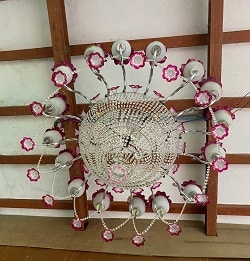
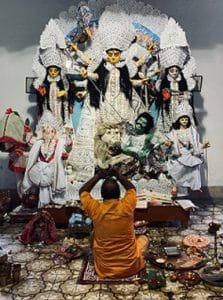
Our drive, which included a number of sharp turns through difficult roads, took us to a narrow alley where “Madhusudhan Gupta lane” was scrawled on a weary sign board. Soon, the vehicle stopped in front of a red and white one-storey building, bearing traces of time. At the entrance, a marble plaque proclaimed: ‘This site was the residence of Pandit Madhusudhan Gupta, the first Anatomist in British India, 10th January 1836.” We walked in through a short passage, opening out to a smallish courtyard separating the residential area from the place of worship. A line of trees, behind the courtyard, formed a natural boundary. Turning right, a short flight of steps took us to a wide cemented space, open on three sides, leading to a rectangular room where the goddess resided in her glory. The sunlight bounced from a magnificent chandelier hanging from the arched ceiling, giving the room a surreal glow.
After the usual round of snacks and pleasantries, I settled down for a chat with the Purohit (priest), a rotund man with an affable smile. While elaborating the details of the ritual, he told me that his family’s connection with the pujo went back several generations, predating the time when it became known as Bakshi-barir pujo. To further his claim, he picked up a small figurine from the feet of the Durga idol, holding it in his palm. It was a small statuette with a rudimentary outline of the female form. As if sharing a secret, the Purohit solemnly informed me that this figure, centuries-old, was used for Devi worship by the family’s ancestors. As far as he knew, it went back to the fourteenth century. During those times, the rituals began with the “Bodhan” (awakening of the goddess)7 under five banyan trees which still stand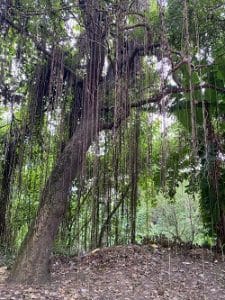
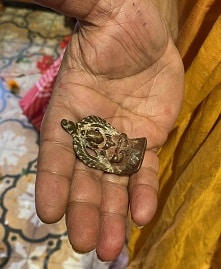
The priest’s narrative was compelling, throwing up shadowy images of a pre modern custom, dissolving time and memory. It left me wondering why historians and iconographers have not spent time validating these stories, trying to unearth details which can lead to interesting often startling discoveries.
What’s in a name?
The history behind the name Bakshi-bari is largely deductive.
A quick search tells us that we have to go back a few centuries to gather clues. Two inferences emerge. The first suggests that it was a titular gift given by the local Nawab of Hugli to Kalicharan Gupta. Kalicharan, who belonged to the Gupta family, was the physician of the Nawab in the early eighteenth century. The other inference indicates that one of the Gupta family members was an employee in the taxation department during the Mughal period.8
The Bakshi title was given as a functional epithet.9 The veracity of both these anecdotes are unsubstantiated by historical evidence. What is evident however, is that the family dropped the title, over time. The name Baksh-bari pujo was allowed to continue, perhaps because it was easily referenceable.
The Bakshi-barir pujo combines a rich assortment of facts, oral history and imaginative storytelling. As we travel back and forth in time, trying to piece together its narrative, we get fascinating glimpses of events which define our past. As the sound of bells and the conch shell separated the silence, there was wondrous feeling of being in a timeless cultural space, surrounded by the heady smell of frankincense, conviviality and the magnetic angry beauty of the goddess’s eyes.
This article was first published on the website The Thinkers’ Club
Footnotes
- An aristocratic home, associated with traditionally refined landowning families
- The autumnal festival dedicated to the invocation of goddess Durga. Puja means worship
- A suburban town 35 km north of Kolkata along the river Hugli
- Worship of the goddess in the family home of the Bakshis
- The second day of the puja, and the 7th of the new moon
- It was said to have coincided with the Battle of Plassey in 1757, the first major battle won by the British leading to colonisation of Bengal and later the entire subcontinent,
- The five day worship begins with this ritual on the 5th day of the new moon
- This section is from Dr. S.K Gupta, Kolkatar Medical Colleger Gorar Katha O Madhusudhan Gupta (The early history of Calcutta’s Medical College and Madhusudhan Gupta), Sahitya Sangsad, 2014
- Bakshi refers to an officer who collects revenue on behalf of the King in Persian
